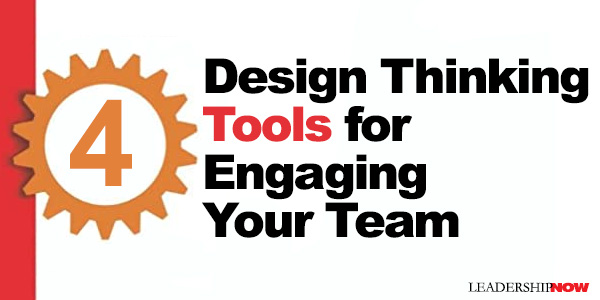 |
 |
08.29.13

4 Design Thinking Tools for Engaging Your Team
APPLYING the tools of design thinking to help your team conquer its goals doesn't mean hunkering down on your own with an org chart in a dimly lit office to devise the perfect execution strategy. Design thinking is about engaging with your team at its most fundamental levels. It's amazing how many little problems germinate at the earliest stage – the problem definition stage – and expand into bigger problems whose solutions also grow in complexity. Finding clever solutions to big, tough, problems requires harnessing your managerial creativity to really understand the problem you and your team are solving. Creativity—contrary to popular myth—does not emerge spontaneously from nothing. One way to think about creativity is as the novel synthesis of data. Those creative shower moments rely on lots of data. If there is no data to mull over, then it's just a boring showing. Below are four design thinking tools that you, as the manager of a talented team, can use to build a creativity-enhancing dataset. All of that data, cleverly applied, will extend your team's ability to boost its operational and innovative performance. Design thinking is a method for understanding complex problems – to really get at their genesis – and developing ways to eliminate or, better yet, leverage those problems into novel solutions. While this still sounds cryptic and too-good-to-be-true, these tools can sharpen your creativity to help you uncover obscured facts and use your knowledge in new ways. Where problems lurk unnoticed How well do you really understand how your team executes a typical project from day one to the very end? There are different stages in a project. Team members' daily roles can be different depending on the project life-cycle. They have a lot of data some of which may even be hidden from themselves. Journey mapping is the art of observing what is really going on. Where are your team members using improvisations to overcome a process deficiency? Heck, you and your team may be so used to making some shortcuts that you don't even see them. Journey mapping requires careful investigation of the process. Yes, it's time-consuming, but you've probably already solved the easy problems, and finding the really deeply embedded problems requires objective observation. Collectively mulling the data Mind mapping is a method for finding useful patterns hiding in lots of noisy data. All of those observations can get you and your team thinking about what's happening throughout the project lifecycle. You have to help your team articulate those ideas and capture them. Sticky notes are the stock-in-trade of design thinkers. Everyone on the team armed with a block of sticky notes is a source of deep process knowledge and ideas. Getting the team around a table and sharing ideas and recording them on sticky notes is a method of capturing institutional knowledge, some of which may not have been explicitly articulated before. After many rounds of sharing ideas and letting everyone build on ideas, you'll be able to see a rich set of patterns. Use the patterns to isolate problems. Looking for a path Hypothesis generation is about figuring out what creates the problems and how to solve them. Solutions aren't solutions until you know that they work as you expect. Until then, your proposed solutions are just hypotheses. That's a pretty powerful notion really. Hypotheses can be wrong or need tweaking and that's fine. Your team can offer hypotheses without the turmoil of suggesting solutions that may fail. Figuring out if a hypothesis holds water is easier and more productive than starting at this point to create The Solution based only on the data that you have so far. Hold back on jumping to The Solution. There are still steps that will help produce even better outcomes. Using your hands to activate your brains Prototyping helps you prove or disprove the hypotheses. You can prototype anything including processes. Allow time and space to try things out physically. PowerPoint presentations full of fancy renderings are good for generating excitement. Prototypes generate hard data, not ephemeral comments about ‘good ideas.' Prototypes are ideas that you and your team touch and are often underestimated beyond the world of product design. How do these design thinking tools boost your managerial creativity and your team's achievements? Our research with high performing teams at large multinational companies like Toyota and IBM all the way to non-profit organizations that have used design thinking has uncovered many team enhancements. These activities listed above engage the whole team. These steps work best when as many of the team members participate as possible. There's a boost in cross-team communication enriching collaboration. A better communicating and collaborating team ultimately generates comprehensive ideas leading to higher-quality activities. Your management skills will help them spend time really understanding the problem. Too often we want to start working on The Solution. Disruptive and highly valuable innovations come from really understanding the problem and finding a solution that really nails the problem rather than put a bandage over the symptoms. It takes a creative manager to engage their teams deeply, and that deep engagement engenders trust and sense of purpose.  
Posted by Michael McKinney at 09:42 PM
|
BUILD YOUR KNOWLEDGE
 

How to Do Your Start-Up Right STRAIGHT TALK FOR START-UPS 
Grow Your Leadership Skills NEW AND UPCOMING LEADERSHIP BOOKS 
Leadership Minute BITE-SIZE CONCEPTS YOU CAN CHEW ON 
Classic Leadership Books BOOKS TO READ BEFORE YOU LEAD |